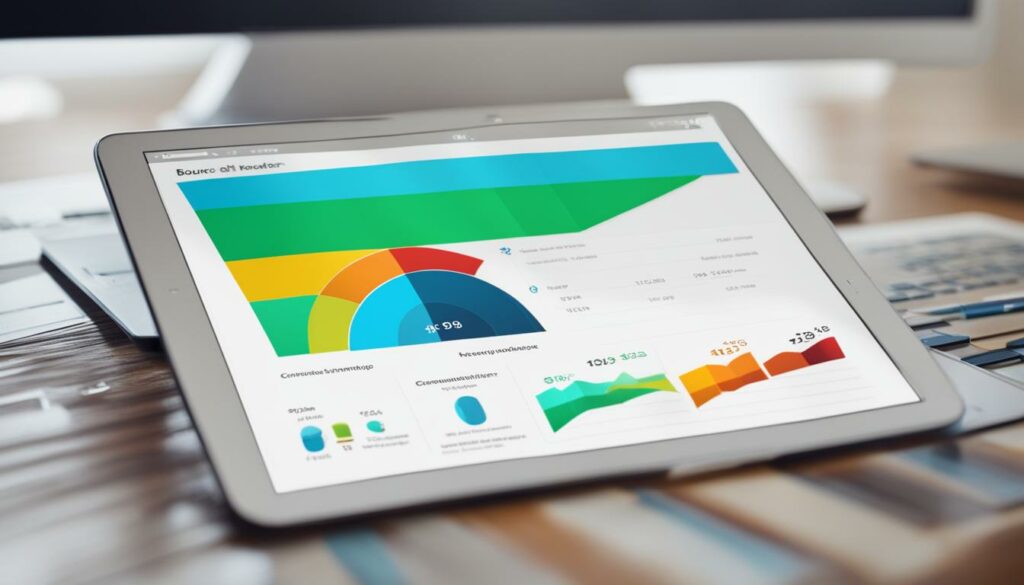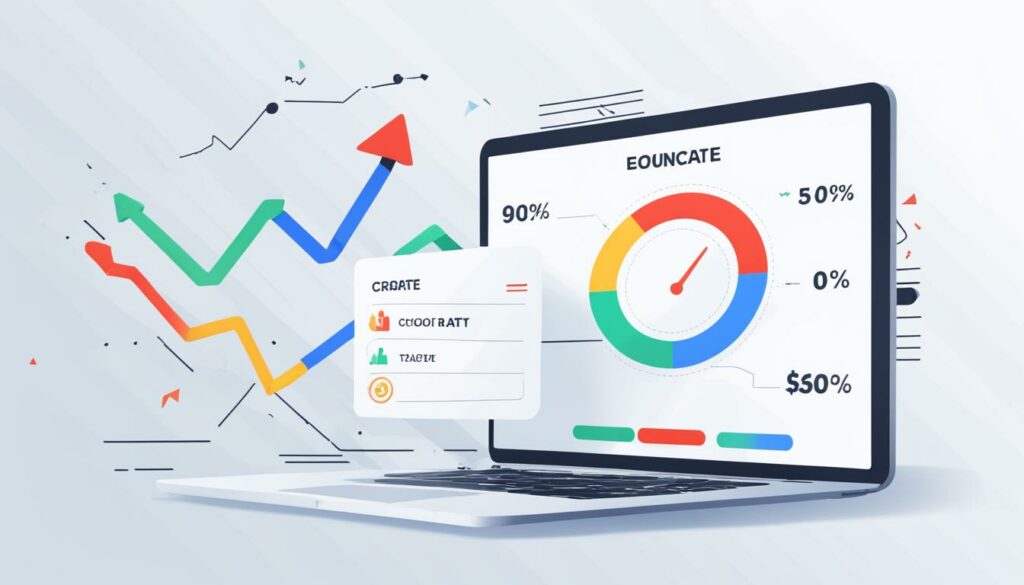Welcome to the world of ecommerce, where the success of an online business hinges on engaging customers and driving conversions. One crucial metric that provides insights into customer behavior and website performance is the bounce rate. In this article, I will explain what bounce rate means in ecommerce and why it is important for your business.
Bounce rate in ecommerce refers to the percentage of visitors who leave a website after viewing only one page, without taking any further action or clicking through to other pages. This metric helps measure the effectiveness of your website in capturing and retaining visitors’ attention. A high bounce rate can signal issues with customer engagement, usability, or the availability of information that influences their decision-making process.
To understand bounce rate, it is essential to calculate it accurately. To calculate the ecommerce bounce rate, divide the number of bounced sessions (sessions with only one page view) by the total number of sessions or visits to the website.
Now that we’ve covered the basics, let’s delve deeper into why a high bounce rate is a bad sign for your ecommerce business and explore ways to reduce it. Understanding customer behavior and analyzing other ecommerce metrics alongside bounce rate will provide a comprehensive view of your website’s performance.
Key Takeaways:
- Bounce rate in ecommerce refers to the percentage of visitors who leave a website after viewing only one page.
- A high bounce rate can suggest difficulties in customer engagement, usability issues, or a lack of information on the website.
- To calculate the ecommerce bounce rate, divide the number of bounced sessions by the total number of sessions or visits to the website, and multiply by 100.
- A high bounce rate in ecommerce can lead to low conversion rates and negatively impact business success.
- To reduce bounce rate, focus on improving website usability, optimizing for mobile devices, and providing accurate and up-to-date content.
What is Bounce Rate?
Bounce rate is a crucial metric in the world of ecommerce that measures the percentage of visitors who land on a website, view only one page, and then leave without taking any further action. It provides valuable insights into customer engagement and the effectiveness of a website in capturing and retaining visitor attention.
In simple terms, bounce rate is the ratio of one-page visits to the total number of visits to a website.
For instance, if a website receives 100 visits in a day and 40 of those visits result in individuals leaving after viewing only one page, the bounce rate would be 40%.
Understanding Bounce Rate
In Universal Analytics, a bounced session refers to someone who views a single page without interacting with it. It does not take into account the duration of the visit or other engagement factors. However, with the advent of Google Analytics 4, the concept of ‘engaged sessions’ has emerged. This approach considers additional factors such as time spent on page, conversion actions, and multiple page views.
The primary goal of measuring bounce rate is to determine if users are truly engaged by the website. A high bounce rate suggests that visitors are not finding what they are looking for or are not compelled to explore further, while a low bounce rate indicates a higher level of engagement.
Factors Influencing Bounce Rate
Several factors can contribute to a high bounce rate:
- Poor website design or layout that confuses or frustrates visitors
- Lack of relevant and compelling content
- Slow website loading speed
- Difficulties in mobile responsiveness and usability
- Ineffective call-to-action prompts
Reducing bounce rate involves optimizing these elements to enhance user experience and encourage visitors to explore further within the website.

How to Calculate Ecommerce Bounce Rate
To accurately measure the ecommerce bounce rate, you need to follow a simple calculation. Divide the number of bounced sessions, which refers to sessions with only one page view, by the total number of sessions or visits to the website. Multiply the result by 100 to obtain the percentage representation of the bounce rate. Let me break it down with an example:
Imagine your website had 10 sessions, and out of those, 3 sessions resulted in a single page view without any further interaction. To calculate the bounce rate:
Bounced Sessions = 3
Total Sessions = 10
Applying the formula: (Bounced Sessions / Total Sessions) * 100
(3 / 10) * 100 = 30%
Therefore, the bounce rate in this example would be 30%.
Tracking and monitoring your ecommerce bounce rate is integral to understanding how engaged visitors are with your website. A high bounce rate might indicate a need for optimization and improvements to enhance customer engagement and conversion. By regularly calculating and analyzing your bounce rate, you can make informed decisions to improve the user experience and increase conversions.
| Session | Pageviews | Bounced |
|---|---|---|
| 1 | 3 | No |
| 2 | 1 | Yes |
| 3 | 2 | No |
| 4 | 1 | Yes |
| 5 | 4 | No |
Why is a High Bounce Rate a Bad Sign for Ecommerce?
A high bounce rate in ecommerce can be detrimental to the success of a website. When visitors arrive on your site but quickly leave without exploring further, it indicates that they are not finding what they are looking for or are not engaged by your content. This could be due to various reasons:
- Website Usability: If your site is difficult to navigate, has slow loading times, or lacks clear calls-to-action, visitors may become frustrated and leave.
- Navigation: Poorly organized menus and confusing navigation can make it hard for visitors to find the information or products they need.
- Insufficient Information: If essential product details, pricing, or shipping information are missing, visitors may leave without making a purchase.
A high bounce rate is particularly concerning because it can lead to a low conversion rate. Visitors who leave without taking any action are less likely to become paying customers, resulting in lost sales and revenue. Additionally, a high bounce rate can negatively impact search engine rankings, as search engines may perceive a lack of relevance or poor user experience on your website.
It is crucial for ecommerce businesses to identify and address the reasons for high bounce rates. By improving website usability, optimizing navigation, and ensuring the availability of comprehensive and accurate information, businesses can enhance customer engagement and increase conversions.
A high bounce rate is like leaving money on the table. It’s essential to make your website a compelling and user-friendly destination for visitors, encouraging them to stay, explore, and ultimately make a purchase.

Ways to Reduce Bounce Rate
To reduce the bounce rate in ecommerce, it is essential to understand why visitors are leaving the website quickly. By identifying the underlying reasons, you can implement effective strategies to improve bounce rate and engage your target audience. Here are some actionable steps to reduce bounce rate in ecommerce:
- Fix Technical Issues: Ensure that your website is free from any technical glitches or errors that may hinder user experience. This includes optimizing page loading speed, fixing broken links, and resolving compatibility issues across different devices and browsers.
- Improve Website Usability: Enhance the overall user experience by simplifying navigation, improving website layout, and ensuring intuitive design. Make it easy for visitors to find what they’re looking for and encourage them to explore other relevant pages on your site.
- Optimize for Mobile Devices: With the increasing use of smartphones and tablets for online shopping, it’s crucial to have a mobile-responsive website. Ensure that your ecommerce site is optimized for various screen sizes, providing a seamless browsing experience for mobile users.
- Provide Accurate and Up-to-Date Content: Display accurate and relevant product information, clear descriptions, and high-quality images. Update your content regularly to reflect changes in inventory, pricing, or promotions, building trust and credibility with your visitors.
- Improve Structure and Navigation: Organize your website in a logical and user-friendly manner. Implement clear categories, filters, and search functionality to help visitors quickly find what they need. Optimize your menu structure and include prominent calls-to-action to encourage deeper engagement.
- Analyze Customer Feedback: Gain valuable insights by conducting surveys or soliciting feedback from your customers. Understand their pain points, preferences, and expectations when browsing your site. Use this information to address issues and continuously enhance the user experience.
By implementing these strategies, you can significantly reduce bounce rates and create a more engaging and conversion-friendly ecommerce website.

Example Table: Bounce Rate Comparison
| Website | Industry | Bounce Rate |
|---|---|---|
| Website A | Fashion | 58% |
| Website B | Electronics | 42% |
| Website C | Home Decor | 32% |
The table above illustrates a comparison of bounce rates in different industries. It highlights the variance in bounce rates and emphasizes the importance of considering industry benchmarks when evaluating your website’s performance. Analyzing industry-specific data can provide valuable insights for setting realistic targets and benchmarking your ecommerce website against competitors.
Customer Behavior and Bounce Rate
Understanding customer behavior is crucial when analyzing and addressing bounce rate in an ecommerce website. Customer behavior directly influences the bounce rate, as visitors may quickly leave if they encounter challenges or frustrations while navigating the site. Addressing customer needs and improving their experience can help reduce bounce rates and increase overall customer satisfaction.
One common reason for high bounce rates is when visitors are unable to find the information they need. This can occur if the website’s structure is confusing or if the content is not easily accessible. Navigation should be intuitive, and information should be organized and readily available to customers, ensuring they can find what they’re looking for without frustration.
Providing Sufficient Information
Customers may also leave an ecommerce store if they do not receive enough information to make an informed purchase decision. It is essential to provide detailed and accurate product descriptions, clear pricing, and relevant images to help customers understand the product or service being offered. Including customer reviews and testimonials can also build trust and confidence in the online shopping experience.
“Customer behavior and bounce rate are closely related. By addressing customer needs and improving the overall website experience, ecommerce businesses can reduce bounce rates and enhance customer engagement.”
Optimizing User Experience
To minimize the bounce rate, optimizing the overall user experience is crucial. Websites should be visually appealing, easy to navigate, and responsive on various devices. Ensuring fast loading times and a seamless checkout process can also improve customer satisfaction and prevent visitors from leaving the website prematurely.
Monitoring and Analysis
Regular monitoring and analysis of customer behavior and bounce rate data are essential for identifying trends and areas for improvement. By tracking user interactions, such as click-through rates, time spent on pages, and exit pages, ecommerce businesses can gain valuable insights into the reasons behind high bounce rates. This data can then inform strategies for optimizing the website and enhancing the customer experience.
Building Customer Relationships
Developing strong customer relationships is another effective way to reduce bounce rates. By providing personalized recommendations, offering discounts or promotions, and implementing customer loyalty programs, ecommerce businesses can foster customer loyalty and encourage repeat visits. Engaging with customers through email marketing or live chat support can also strengthen the connection and improve the chances of customers staying on the website.
| Key Strategies to Reduce Bounce Rate: | Benefits: |
|---|---|
| Optimize website navigation and structure | Enhanced user experience and easier access to information |
| Provide detailed product descriptions, pricing, and images | Improved understanding and informed purchase decisions |
| Optimize website for different devices | Reduced barriers and improved accessibility |
| Monitor and analyze customer behavior data | Identification of trends and areas for optimization |
| Develop personalized recommendations and loyalty programs | Stronger customer relationships and increased loyalty |
Relation to Other Ecommerce Metrics
Bounce rate is a crucial metric for evaluating the performance of an ecommerce website. However, it should not be considered in isolation. There are several other metrics that provide valuable insights into how visitors interact with the website and can help identify areas for improvement in the overall ecommerce strategy.
Website Traffic:
Tracking website traffic is essential for understanding the volume and source of visitors to an ecommerce website. By analyzing website traffic, you can determine the effectiveness of marketing campaigns, identify high-performing traffic sources, and make data-driven decisions to optimize your online presence.
Time on Page:
The amount of time visitors spend on a page indicates their level of engagement with your content. A high bounce rate combined with a short average time on page may suggest that visitors are not finding the information or products they are looking for, highlighting the need for improved website content or navigation.
Device Type:
Understanding the devices visitors use to access your ecommerce website is crucial for optimizing the user experience. By analyzing device types, such as desktop, mobile, or tablet, you can identify any disparities in website performance across different devices and tailor your design and functionality accordingly.
Location:
Geographic data provides insights into the regions where your website is most popular and where potential customers are located. This information can help you tailor your marketing campaigns, optimize shipping options, and personalize the user experience to better accommodate the preferences and needs of your target audience.
Conversion Rates:
While bounce rate indicates whether visitors are engaged with your website, conversion rates measure the effectiveness of your ecommerce funnel. Tracking key conversion metrics such as add-to-cart rate, checkout completion rate, and overall conversion rate can help you identify areas for improvement in the purchase process and optimize your website for higher conversion rates.
| Ecommerce Metrics | Description |
|---|---|
| Website Traffic | Number of visitors to the website and their source |
| Time on Page | Average length of time visitors spend on a page |
| Device Type | Types of devices used by visitors to access the website |
| Location | Geographic location of website visitors |
| Conversion Rates | Percentage of visitors who complete a desired action or make a purchase |
By analyzing these ecommerce metrics alongside the bounce rate, you can gain a comprehensive understanding of how visitors interact with your website and identify areas for improvement to enhance customer engagement and drive conversion rates.
Challenges and Considerations
When it comes to assessing customer engagement in ecommerce, bounce rate is a valuable metric. However, it is important to be aware of the challenges and considerations that come with interpreting and using this data effectively.
One of the main challenges is the wide variation in bounce rates across industries. What may be considered a high bounce rate for one brand or sector may be entirely acceptable for another. It’s crucial to have industry benchmarks and context in mind when evaluating the bounce rate for your ecommerce business.
Furthermore, it is essential to take into account the specific goals and context of your website. Different pages on your site may have different intent and objectives, which can influence the expected bounce rate. For example, a landing page designed to capture leads may have a higher bounce rate than a checkout page. By understanding the purpose of each page, you can set realistic expectations for bounce rates.
Another consideration is that bounce rate should not be examined in isolation. To gain a comprehensive understanding of customer behavior, it is important to analyze bounce rate in conjunction with other metrics. Factors such as traffic sources, time on page, conversion rates, and device type can provide valuable insights into user engagement and help identify potential areas for improvement.
To stay ahead of the game, regular monitoring and analysis of bounce rate data is necessary. By identifying trends and patterns over time, you can uncover any potential issues and make informed decisions to optimize your ecommerce business. Understanding the challenges and considerations associated with bounce rates will enable you to navigate this metric effectively and drive success in your online venture.
FAQ
What is bounce rate in ecommerce?
Bounce rate in ecommerce refers to the percentage of visitors who leave a website after viewing only one page, without taking any further action or clicking through to other pages.
How do you calculate ecommerce bounce rate?
To calculate the ecommerce bounce rate, divide the number of bounced sessions (sessions with only one page view) by the total number of sessions or visits to the website. The result is then multiplied by 100 to get the percentage.
Why is a high bounce rate a bad sign for ecommerce?
A high bounce rate in ecommerce can indicate that the website is not effectively engaging customers or providing them with what they are looking for. It can lead to a low conversion rate and negatively impact the success of an ecommerce business.
How can I reduce bounce rate in ecommerce?
Some strategies to reduce bounce rate in ecommerce include fixing technical issues and improving website usability, optimizing the website for mobile devices, ensuring the content is up-to-date and accurate, and improving the overall structure and navigation of the website.
How does customer behavior affect bounce rate in ecommerce?
Customer behavior plays a significant role in bounce rate. Visitors may leave a website quickly if they are unable to find the information they need or if the website is difficult or confusing to navigate. Understanding customer behavior and addressing their needs can help reduce bounce rates and improve customer satisfaction.
What other ecommerce metrics should I consider alongside bounce rate?
Other metrics to look at alongside bounce rate include website traffic, traffic sources, time on page, device type, location, and conversion rates. These metrics provide a comprehensive view of how visitors interact with the website and can help identify strengths and weaknesses in the overall ecommerce strategy.
What are the challenges and considerations for bounce rate in ecommerce?
Bounce rates can vary widely by industry, and what may be considered a high bounce rate for one brand may be acceptable for another. It is also important to consider the context and specific goals of the website when evaluating bounce rate. Additionally, the bounce rate should be analyzed in conjunction with other metrics to gain a more comprehensive understanding of customer behavior.
